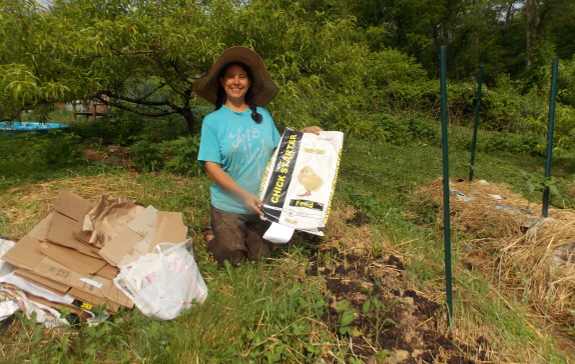
Uses for empty feed bags

We have a lot of uses for
empty feed bags, but my favorite is kill mulching around small
transplants. As you can see in the photo above, the parts of the
garden that spent the winter as rye
are a little weedier than I'd like, so rather than hand-weeding, I'm
laying down a layer of paper bags and then a layer of straw. The
feed bags conform to the soil surface better than cardboard does in this
type of uneven terrain, and they decay just as fast (including the
strings).
When we go somewhere
other than our usual feed store and end up with the plastic-burlap bags,
I generally save the empties for troublesome trash. We're still
pulling old barbed wire and broken glass out of parts of the garden, and
that type of debris will puncture an ordinary trash bag. A
plastic feed bag, though, holds wire and glass with ease.
Mark gets his ingenuity
honest --- from his mother --- and her use for a feed bag takes the
cake. She makes hip handbags out of the empty plastic sacks,
something I'd definitely use if I was a handbag carrier. (I wish I
had a photo to share with you!)
What do you do with your old feed bags?
Want more in-depth information? Browse through our books.
Or explore more posts by date or by subject.
About us: Anna Hess and Mark Hamilton spent over a decade living self-sufficiently in the mountains of Virginia before moving north to start over from scratch in the foothills of Ohio. They've experimented with permaculture, no-till gardening, trailersteading, home-based microbusinesses and much more, writing about their adventures in both blogs and books.
Want to be notified when new comments are posted on this page? Click on the RSS button after you add a comment to subscribe to the comment feed, or simply check the box beside "email replies to me" while writing your comment.

Anna~ I have a question that is completely off topic but if anyone can help me, it would be you guys.... I was checking our 4 year old apple trees (planted the fall of 2012) just as the snow was off in April. And I noticed one of the trees was leaning. When I jiggled the trunk the entire tree came out of the soil into my hand. The roots had been eaten off by ?. (I could even see the teeth marks on the stump.) Because the trunk was chewed below the graft, I thought that I might be able to try and save the tree. So I put the stump end into a bucket of water filled with willow leaves and willow trimmings and waited (the graft was above the level of the water). The tree has leafed out and is beginning to set blossoms and there are small roots showing. These are all good things! Now the question is what now? I was thinking about putting this little guy in a 3 gallon bucket of soil and overwinter it and replant next spring. But I'm not sure how long the roots should be before I pull the tree out of the willow water. And I'm not sure if I should wait until next spring. What do you think? The tree looks great right now but I'm not sure of the next step... Thanks. Elizabeth
Elizabeth --- The exact same thing happened to us this winter, and I'm pretty sure the culprit is voles. I vaccillated and ended up just mounding up earth around the base of the trunk above where the voles gnawed, hoping the trees would reroot. One of our trees is definitely dead, and two look like they might be making a slight comeback. If they stay alive, I'll probably prune them hard so they don't have so many branches in relation to their few roots, and I'd recommend you do the same. If ours had set any fruits, I would also pick all of them off.
Since yours is in a bucket of water, rooting, I'd probably cut it way back, then put it in a pot in a shady location, watering often, as soon as you see roots (now). The tricky part will be making sure that you keep it well enough watered without drowning it. Basically, you're turning the whole tree into a softwood cutting, so it will need lots of babying to stay alive.
I'll be curious to hear what happens!
Ok. Do I guess I'll pot it up, cut it way back (with my eyes closed so it doesn't hurt so bad) and water enough to help the roots establish but not so much to kill it. Well, this WILL be a challenge! I'll let you know how things go!
Thanks for your help.
PS I seem to remember you discussing "roots vs branches" when you prune in a distant post. Can you point me to that post or a general range of dates? Thanks again....
Elizabeth
wow, good luck with the tree!
re uses for feed sacks, the paper ones make great "disposable" floor mats for the farm truck, if you tend to have work boots tracking in mud, grass clippings, straw, etc. When they get too dirty, just pull it out, put a new one in, no big cleaning job. They're still good at that point for sheet composting or recycling, too, so no harm done.